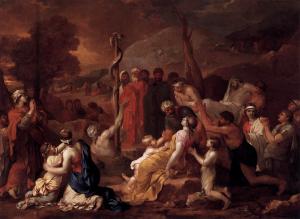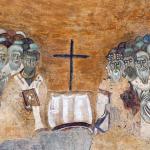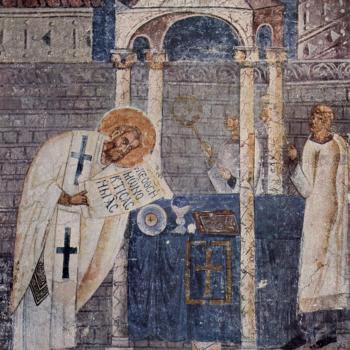
Sadly, one of the tendencies we have as a species is to take something which is good and taint it. We abuse the good as we employ it for some evil ends. This is not to say the good is entirely destroyed by our actions, but it is certainly reduced, as evil corrupts the good by destroying it. What is left of the good needs to be detached from the evil which is using it, but often, that is not easy, and sometimes, the only way we can go forward is to detach ourselves from the good which is being abused so long as it remains associated with the evil which is done in its name.
This is how idolatry, in its many forms, is established. Something which is good, something which can and should be respected, becomes idolized. In that idolization, the good is detached from the holistic good. The idol is then used to turn people away from the greater (or common) good, so that the good itself (and many people and their lives) is sacrificed for the sake of that idolatrous corruption of the good. When the idolatry has become too entrenched that the good has more or less been undermined or annihilated, we must destroy the idol – not because the good which existed before such idolatry was not good (and cannot later be recognized once again, once the idolization has stopped), but because, so long as it remains in its idolatrous form, it will only be used for evil.
Through idolatry, people are attached to lesser goods, to corruption or perverted forms of being. When no other solution arises, when no other ways of overcoming that attachment can be found, we must eliminate that which leads to such attachment, to the idol itself. So long as people excuse such idolatry because of the good which existed before the good was idolized and abused, we end up supporting the continued abuse of that good; only by eliminating its perverted form do we make way for the purity of that good to once again be made known (which is why the destruction of idols must not be a nihilistic enterprise, for if and when it becomes such, then such a movement has become its own idol and needs to be eliminated as well).
This process of taking something good, turning it into an idol, resulting in the need to remove the object of such idolization is found in Scripture with the story of the Nehushtan, that is, the bronze serpent which Moses raised up in the desert to protect the people of Israel from deadly snake bites:
From Mount Hor they set out by the way to the Red Sea, to go around the land of Edom; and the people became impatient on the way. And the people spoke against God and against Moses, “Why have you brought us up out of Egypt to die in the wilderness? For there is no food and no water, and we loathe this worthless food.” Then the LORD sent fiery serpents among the people, and they bit the people, so that many people of Israel died. And the people came to Moses, and said, “We have sinned, for we have spoken against the LORD and against you; pray to the LORD, that he take away the serpents from us.” So Moses prayed for the people. And the LORD said to Moses, “Make a fiery serpent, and set it on a pole; and every one who is bitten, when he sees it, shall live.” So Moses made a bronze serpent, and set it on a pole; and if a serpent bit any man, he would look at the bronze serpent and live (Nu. 21:4-9 RSV).
Apparently, the bronze serpent (or some copy or representation of it) was preserved, and slowly became an object of idolization. What established by Moses through the command of God could only be seen as being good, for what God commands and what we execute from such a command will be good. However, the good was perverted. What was meant to be a sign pointing to God and his goodness (and with it a sign indicative of the messianic work to come with Jesus on the cross), was turned into an object of adoration which led people to become attached to it and ignore the greater, continuing presence of God in the community. They were not willing to develop beyond their primitive understanding of God. Being stuck in the past, the people became attracted to a distorted view of God; eventually the distortion became so great, the only recourse was to have the snake destroyed:
In the third year of Hoshea son of Elah, king of Israel, Hezekiah the son of Ahaz, king of Judah, began to reign. He was twenty-five years old when he began to reign, and he reigned twenty-nine years in Jerusalem. His mother’s name was Abi the daughter of Zechariah.
And he did what was right in the eyes of the LORD, according to all that David his father had done. He removed the high places, and broke the pillars, and cut down the Asherah. And he broke in pieces the bronze serpent that Moses had made, for until those days the people of Israel had burned incense to it; it was called Nehushtan. He trusted in the LORD the God of Israel; so that there was none like him among all the kings of Judah after him, nor among those who were before him (2 Ki. 18:1-5 RSV)
The destruction of the brazen serpent did not remove history, nor did it deny the good which was done by Moses; rather it denied the way it was being presented and understood by the people during the time of Hezekiah. Perhaps they were using it to connect the people to various polytheistic serpent cults, undermining the transcendent qualities which had become recognized of Yahweh; perhaps, with the incense, they were practicing sacrificial rites associated with Canaanite traditions, which is why it was mentioned with the Asherah. We do not know all that was associated with the cult of the Nehushtan other than, in some form or another, the good which was associated with the serpent staff was perverted and was leading some of the people of Israel into idolatry. What is important in the story is how it shows us idolatry develops and what makes it so dangerous: it takes something which is good and subverts the good, using the good associated with it to attract people to dangerous ideological conclusions which must be rejected.
Those who criticize such idolatry, in any of its forms, have to contend with the defenses given to such idolatry. They have to contend against people who will use history and tradition as an excuse to preserve what has been transformed into idols. Someone could have accused Hezekiah of trying to erase history by destroying the Nehushtan, but that was not his intention at all; he was trying to put a stop to the idolatrous attachment that led to dangerous ideologies in his kingdom. We must recognize, then, that sometimes the way to return to the good which has been lost is to put an end to that which is being used to lead people astray. The past is not being destroyed, history is not lost when idols are removed, rather, the past becomes free and we are once again able to learn from it.
Thus, we can and should be able to both recognize and respect the good of the past, the holiness of relics (for the brazen serpent was preserved for centuries), without accepting any ideological baggage which turns the good into some evil. We must remember the greater good, knowing that its promotion is the promotion of God and God’s will. Thus, as St. Ambrose, St. Augustine, and others understood, even the sacred vessels which are used in churches are meant for our own good, and if they can be put to use to help us overcome some great evil, it is better to use them in such a manner than it is to hold onto them, and let people suffer needlessly. Thus, as Possidius explained, Augustine (and Ambrose before him) were concerned for the poor and needy, and they used whatever they could to help those in need:
Meanwhile, if his church needed money he told the Christian people that he had nothing to give to the poor. For the benefit of captives and the large number of needy he ordered the holy vessels to be broken and melted down for distribution among the poor. I would not have mentioned this fact if I did not see clearly that this was done contrary to the carnal judgment of some men. Ambrose of venerable memory, both in speaking and in writing, ordered the same procedure without any hesitation in such extreme cases. [1]
In this manner, Augustine and Ambrose pointed to the relative good associated with the sacred vessels in the church; they should not be turned into idols which require people to sacrifice their lives for their continued use. Carnal thoughts and practices would end up attaching more significance to such material objects than the lives of people, and it is in this fashion, idolatry establishes itself and creates the means by which people are needlessly sacrificed.
Idolatry leads to the destruction of human dignity. It puts some particular, individualized objective over and above the common good. So long as the dignity of the human person is ignored, so long as an object ends up promoting the destruction of human life and dignity, it becomes an idol which must be overturned. This explains why other similar objects, when used to help promote the common good and human dignity, are not idols. Indeed, because they can and do promote such, we see how different they are from their idolatrous counterparts, and why they can be recognized as sacred objects, that is, objects infused with grace that can do some good in the world. The key is to treat them with care and with such a relative understanding of their goodness so that we do not end up attaching ourselves too much to them and turn them into idols.
[1] Possidius, “Life of St. Augustine” in Early Christian Biographies. Ed. Roy J. Defferrari (Washington, DC: CUA Press, 1952; repr. 1992), 103.
Stay in touch! Like A Little Bit of Nothing on Facebook.
If you liked what you read, please consider sharing it with your friends and family!












